Failed wall assembly
I had some questions with regard to some pictures of a “failed” wall assembly that was shown to me. I included (attached) a few pictures.
The “back story” on this wall assembly.., a 20-25 year old wall assembly in Northeast Massachusetts which consists of:
From the outside of the building to the interior…
• Cedar vertical siding
• Tyvek house wrap
• ½” or 5/8” CDX plywood
• white mold (on interior sided) of ½” or 5/8” CDX plywood
• 2”x6” kd wall studs
• R19 unfaced fiberglass insulation
• Foam board (XPS) attached to the inside of the wall studs. Not quick sure of the thickness of the XPS
• Sheet rock (½”) wall board on top of that foam board on the interior 2×6 studs
• Latex paint (not sure of how many coats of paint)
The interior rooms of the building, where these exterior rotted walls are at contain two bathrooms, one on the first floor and one on the second floor. You can see the PVC drain pipes in the exterior wall.
My assumption here from what I can see in the pictures… is that the interior foam board (XPS) on the inside wall was supposed to function as the vapor barrier… although the plumbers created some pretty big holes in the original installation…which leads me believe there-in lies the wall failure problem… a failed interior vapor barrier. I assume condensation ensued onto the interior side of the exterior CDX sheathing from the heated warm moist air in the bathrooms, causing the moisture build up and white mold on the interior side of the exterior CDX… and eventually the wall root failure.
My question is on the concept of “drying to the outside” in a wall assembly with the vapor barrier on the inside. Why wouldn’t a wall assembly like this “dry to the outside? One note here… the cedar vertical siding was in great shape (solid), on the inside non-exposed side (to the plywood CDX) and the exposed exterior side (to the outside elements). It seems as though the cedar siding did ok.
The pictures shown here were taken after the wall studs were repaired to the wall assembly… but I don’t see the original vapor barrier issue being addressed. Not quite sure how the final situation was remedied.
I would assume from my GBA readings, that this situation could be remedied by:
Fixing the XPS holes and completely taping and sealing the XPS on the interior of the stud wall before the wall board goes up.
… or …
Could a solution be to have your sheetrock wall board (with NO 6 mil plastic vapor barrier on the interior), then your fiberglass insulation, then use XPS (at least 1”) on the exterior wall side of the CDX, then your cedar siding. With regard to the cedar siding… would a “rain screen wall” on the outside of the CDX siding be absolutely necessary in this wall assembly.
Do these solutions sound correct? Which wall assembly would be better in this case?
Any additional commentary or insight would be greatly appreciated.
– JP
GBA Detail Library
A collection of one thousand construction details organized by climate and house part


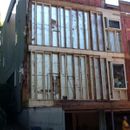
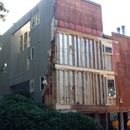
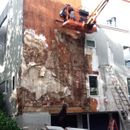
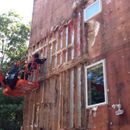
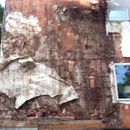







Replies
J.P.,
When you get sheathing rot like this, the first question is, "What's the source of the water?" Since the rot patterns don't seem to be associated with windows or penetrations, I'm going to guess that the source of the moisture was the interior air. My guess is that this building was never properly air sealed, and that moisture piggybacking on the exfiltrating air saturated the cold sheathing.
Of course, it's impossible to be sure what is going on without a site visit.
There are several ways to make this wall more robust:
1. Warm up the sheathing by installing a layer of rigid foam on the exterior side of the sheathing; this foam would have to be thick enough to keep the sheathing above the dew point in winter. This remedy requires the removal of the interior rigid foam.
2. Improve air sealing to limit air leakage.
3. If the clients don't want to install exterior foam, the wall can be made more robust by switching to a sheathing that is more vapor-permeable -- for example, fiberboard -- and including a ventilated rainscreen gap between the sheathing and the siding.
There are also some obvious risk factors here for water getting into the wall from outside. It's a large vertical surface without a roof overhang, and could be exposed to driving rain. Tyvek dissolved under the cedar (a known problem with Tyvek of the era). No rainscreen gap. Vertical siding is more leaky than horizontal because rain rinses around to the interior on the way down the joints. The rotting is worse toward the bottom, where more water would end up due to gravity.
T.J.,
Excellent observations. In general, it is far more likely for the source of moisture to be rain than indoor air, so you may well be right.
What TJ said.
With a vented rainscreen gap and another foot of overhang it probably would have hung in there just fine. Note that the top of the wall for a few feet below the drip edge the CDX appears to be in good shape, getting progressively worse as you go down. That's a rain-penetration pattern.
The thickness of the XPS matters over the longer term- if it's at least an inch thick it would be a sufficient vapor retarder to not load up the CDX from vapor diffusion but if it's only half-inch 6 mil poly or MemBrain would work, provided the holes got fixed, of course.
I'm adding this one to my "Enclosure Failures" Pinterest Board
http://www.pinterest.com/johnkbrooks/enclosure-failures/
John,
That's a cheerful collection of photos!
Martin, many / most of the photos link back to GBA articles
the Pinterest boards are a handy (and visual) way to keep links to "Favorite" articles
Thanks for the commentary and further insight...
Martin, I think TJ pretty much nailed this one. I do like your thoughts on the fiberboard wall sheathing. I as a young framer hated this stuff as it usually clung to you on those hot sweaty days of summer as you cut it to fit with a power saw. However as a moisture consultant I have come to appreciate its ability to somewhat manege incidental moisture.
John, good photos I see you even have a couple of mine. Email me and I will contribute some more; i do have some real good (bad, horrific) ones.